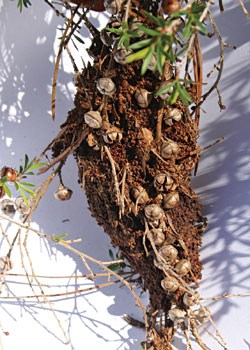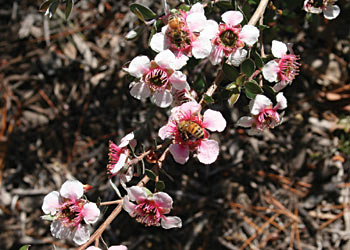
Teatree Web Moth (Webbing Caterpillar)
Ben Walcott
Many of us gardening in the Canberra region are familiar with the teatree web moth. It is a common pest that usually attacks the lower branches of certain leptospermums and melaleucas. The branches become bare of leaves and encrusted with a webbing material full of brown dust-like material. I have never seen the larvae at work but the results can be quite devastating to the plant. The culprit is Orthaga thyrsalis (formerly Macalla thyrsalis) which is found in most of Australia. A related species of the same genus is a pest on mangoes here and in other parts of the world.
 |
|
Branches become bare of leaves and encrusted with a webbing material full of brown dust-like material
Photo: Ben Walcott |
|
Our experience is that small leaved leptospermum hybrids such as 'Pink Cascade', 'Cardwell', 'Outrageous', 'Pageant' and 'Merinda' are highly susceptible while those with larger leaves such as the cultivars 'Mesmer Eyes', 'Rudolf' and 'Aphrodite' are not affected. In the case of the melaleucas we had to remove three quite large dwarf Melaleuca decussata plants because they were so badly affected. M.thymifolia plants also seem to get periodic invasions of webbing caterpillar but not to the extent that they denude large areas of the plants of leaves. Another melaleuca that seems to suffer attacks is M.hypercifolia and its prostrate form 'Ulladulla Beacon'. These plants have larger leaves than the relatively immune leptospermums 'Rudolf' etc, so leaf size is not the only factor determining caterpillar attack.
It has also been our experience that plants that are really healthy and thriving are somewhat less susceptible to the caterpillar. In terms of control, we have tried manually removing the 'nests' of material and cutting out the affected branches. This treatment seems to have rather limited effect. The cutting of limbs can make the plant very unsightly and the moths seem to return to the remaining parts of the plant.
We have tried spraying with the insecticide ConfidorŽ with little success. A common treatment reported in some books is with Carbaryl (2g/L) which is otherwise known as SevinŽ. However this insecticide is toxic, particularly to bees and other beneficial insects, as well as to the target moth. It should be used with great care as it is also toxic to humans. It does have a fairly low persistence in the soil (14-28 days in clay soil) being broken down by microbes and sunlight which is an advantage. In India where a related species of webbing moth is a pest on mangoes, it has been reported (Girish, K., Shankara Bhat, S. 2008 Neem-a Green Treasure. Electronic J. Biology 4 (3) 102-111) that extracts from the Neem tree, specifically Nimbicidine, is an effective systemic pesticide. It is harmless to bees and humans but affects chewing insects. It is not commonly available in Australia unfortunately.
 |
 |
The Walcott's experience is that small-leaved leptospermum hybrids such as 'Pagent' (left) are highly
susceptable to teatree web moth while those with larger leaves, such as the cultivar
'Mesmer Eyes' (right), are not affected.
Photos: Ben Walcott. |
At present, we have chosen simply not to plant small leaved leptospermums and melaleucas in our Canberra garden. Those that we have, where the infestation gets severe, we remove them and replace them with other cultivars and species.
From the newsletter of the Australian Native Plants Society (Canberra), March 2009.
Australian Plants online - 2009
Australian Native Plants Society (Australia)
|